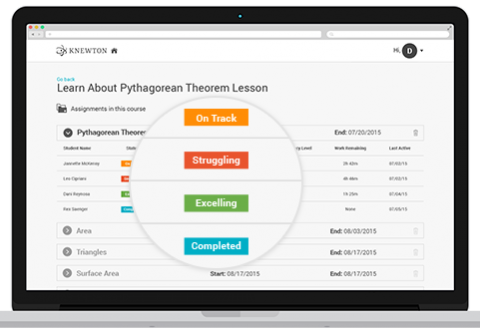Everywhere you look today, industries are going digital. The power of digital tech and innovation is no longer reserved for high-tech industries and computer wonks. Managers and industry leaders in even the stodgiest industries are coming around to the promises of digital transformation.
In this series, we’re taking a look at some of the industries that are starting to jump on the digital transformation bandwagon. In this post, we’ll give you the run-down on digital innovation in education.
It’s not all about robot teachers or online classes. Educators—from grade one teachers to university lecturers—are experimenting with digital technology in their classrooms. Here are three trends that capture how digital transformation is changing the way students learn.
1. Personalized Learning Environments
 Every student learns differently. Researchers, educators, and parents have known this for years. But turning this knowledge into action has always been tricky. To accommodate different learning styles, teachers first have to learn about each of their students’ individual needs—and that’s a tall order for the large class sizes in most schools.
Every student learns differently. Researchers, educators, and parents have known this for years. But turning this knowledge into action has always been tricky. To accommodate different learning styles, teachers first have to learn about each of their students’ individual needs—and that’s a tall order for the large class sizes in most schools.
That’s where digital innovation comes in. Teachers can use technology to collect data that paints a picture of their students: what their strengths and weaknesses are, how they like to learn, and what doesn’t work for them. Teachers can adapt their teaching style in response so that students receive a more personalized experience.
Adaptive learning systems – computer-based systems that modify the way information and materials are presented in response to student performance – takes this personalization to another level. Essentially, adaptive learning technology collects information about students’ understanding and behavior as they answer questions and instantly adjusts the learning experience accordingly.
Keen to see adaptive learning in action? Check out the example below:
Blended learning is another great example of personalization at work. Blended learning combines traditional face-to-face instruction and interactions between teachers and students with tech-based learning. The idea here is that with a balance between teacher-led and student-led technology supported learning, students get the chance to control where they learn, how fast they work through materials, and what kinds of subjects they explore.
The adoption of tech-based learning systems is one of the biggest trends in education technology today, and it’s easy to see why: the U.S. Department of Education has found that this kind of technology-based instruction can cut down on the time it takes students to reach learning objectives by 30 to 80 percent.
2. Virtual Reality

Virtual reality has come a long way in recent years. Once seen as a gimmicky piece of gaming tech, virtual and augmented reality is making its way into classrooms, replacing history textbooks with virtual trips to Ancient Greece, and letting students wander through rainforests for an ecology lesson.
Take the app Unimersiv for example. It’s loaded with virtual experiences that educate students in history, space, or anatomy, supplemented teachers’ lessons with virtual world experiences. Using the app, students can board the Titanic, explore the International Space Station, and learn about dinosaurs.
Other VR apps help students share their virtual creations with friends, family, and other students. Cospaces is an app that allows you to build your own virtual world and create VR content.
The list of VR apps for education goes on (check out this list for more), and it’s growing every day. And with companies like Magic Leap working to revolutionize the way students interact with their computers, the future of VR in the classroom looks bright.
3) Gamification
 Gamification certainly seems to be cropping up everywhere these days, and education is no exception. Gaming tech can make learning more exciting, engaging, and fun—but it also gives students an opportunity to apply their knowledge and use it to overcome obstacles in the game.
Gamification certainly seems to be cropping up everywhere these days, and education is no exception. Gaming tech can make learning more exciting, engaging, and fun—but it also gives students an opportunity to apply their knowledge and use it to overcome obstacles in the game.
Games mirror real life situations and push students to use new skill sets to solve them. More than just fun, gamification gets students learning by doing. And the immediate feedback and rewards that gaming offers mean students will keep playing long after they would have shut a textbook.
Don’t be fooled – these kinds of learning games aren’t just for kids. Drexel University, for example, collaborated with Tata Interactive Systems to create a simulation-based game for students studying for a certificate in forensics. The program is designed to teach students about conducting assessments at a violent crime scene, providing them with a 3D virtual crime scene complete with evidence and clues. The program also simulates victim and offender interviews. It gives students continuous feedback, new situations to apply their skills in, and the chance to replay their performance to do better on their next go.
Wrap Up
New technology and approaches to learning are transforming today's’ classrooms. Educational institutions from primary schools to colleges are jumping on the digital transformation bandwagon, and digital trends like virtual reality and gamification are slowly finding their way into educational institutions.
